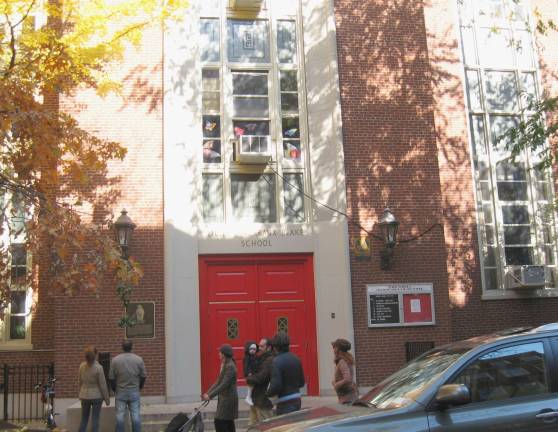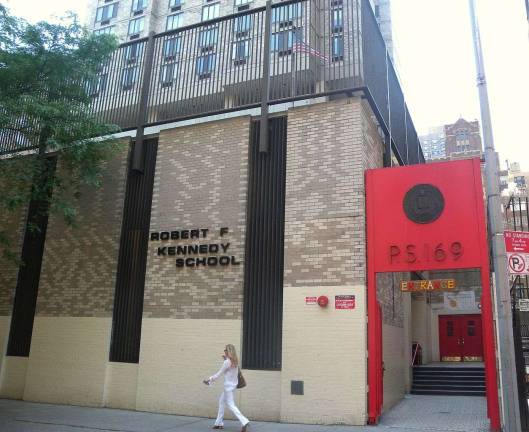Lead in water was common in city schools


Department of Education testing showed that drinking water in a number of Upper East Side schools, including P.S. 6, The Lillie Devereaux Blake School, contained lead at concentrations many times greater than state-mandated action levels for the toxic metal during the last school year.
The New York City DOE completed lead testing on drinking and cooking water outlets in every public school in the city during the 2016-2017 school year. Results showed that 83 percent of school buildings had at least one water sample with lead levels above the action level of 15 parts per billion. Elevated lead levels were found in roughly 8 percent of all samples. After testing, the DOE sent letters notifying parents and staff of their individual school’s results. Results for each building were made available on schools’ individual websites, but a single, comprehensive database of results for each outlet tested in every school was not made available by the DOE until recently, following a freedom of information law request filed by Straus News.
The DOE’s remediation protocol calls for outlets with elevated lead results to be immediately removed from service and replaced. Outlets are not returned to service until follow-up testing shows that lead levels are below the 15 ppb action level.
“Many of the elevated water samples came from fixtures that are not typically used for drinking, including bathrooms, slop sinks, and laboratories,” read one DOE letter to parents and staff. Faucet-level test results, however, show that elevated samples were found in drinking fountains at many schools.
At P.S. 6, The Lillie Devereaux Blake School, an elementary school on East 81st Street that serves children in pre-kindergarten through fifth grade, one classroom drinking fountain had results of 3,268.2 ppb, more than 200 times greater than the 15 ppb action level. Nine other samples taken at the school, all from cold water faucets, also had elevated lead levels.
Three of the 20 samples with elevated lead levels found at the East 100th Street building that houses M.S. 224, the Manhattan East School for Arts & Academics, came from drinking fountains, including one outdoor bubbler with results of 470 ppb. Eighteen percent of samples taken at the building were elevated, one of the highest ratios of any school in the neighborhood.
A higher proportion of elevated results in a given building did not necessarily correlate with higher lead levels in the school’s individual water outlets. For example, only two of the 176 samples tested at P.S. 87 William Sherman on the Upper West Side turned up elevated results, but one was a cold water faucet in a first floor classroom with test results of 1,191 ppb, nearly 80 times greater than the action level.
Other Upper East Side schools that had drinking fountains with elevated results include P.S. 169 Robert F. Kennedy on East 88th Street, which had four, and the Julia Richman Education Complex on East 67th Street, which had one.
DOE Deputy Chancellor Elizabeth A. Rose wrote in an April 2017 letter to families and staff that the department’s testing “demonstrates that we do not have any systemic issues with water in our school buildings and our remediation protocol is effective.” Lead poisoning rates among New York City children have declined in recent years, and according to the DOE there has never been a known case of lead poisoning due to water in city schools.
The DOE has said that elevated lead levels found during testing are not necessarily reflective of actual lead levels students and staff are likely to encounter during the day, as testing was performed on water that had sat in pipes overnight. The DOE says that lead levels drop sharply after faucets are first used each day and stagnant water is cleared from the pipes.
Lead enters drinking water primarily through the corrosion of lead plumbing materials, which are now banned but were once widely used. For adults, exposure to lead over time can result in a number of harmful effects, including increased risk of high blood pressure and kidney disease. Young children, who absorb ingested lead at a higher rate than adults, are particularly susceptible to harmful effects of lead exposure, which can have permanent negative impacts on the development of the brain and nervous system.
The U.S. Environmental Protection Agency emphasizes that there is no safe level of lead exposure. The 15 ppb action level is not a health-based benchmark; rather, it is an action level for implementing treatment techniques aimed at reducing lead levels at the tap. According to the World Health Organization, “There appears to be no threshold level below which lead causes no injury to the developing human brain.”